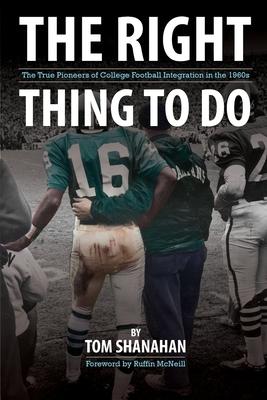Jerry LeVias, Warren McVea and Leon Burton are major figures in college football history, but their accomplishments aren't widely celebrated these days, even at their alma maters. The story of college football integration in the 1960s was ignored by sportswriters of the era, and schools saw little upside to trumpet their racial accomplishments.
The stories of these groundbreaking college football pioneers and the coaches who fought for integration-led by Michigan State's Duffy Daugherty and his coaching tree, featuring the likes of Dan Devine, Chuck Fairbanks and Bill Yeoman-are compiled for the first time in The Right Thing to Do: The True Pioneers of College Football Integration. From award-winning journalist Tom Shanahan, The Right Thing to Do addresses the official racial quota system in the 1960s college football world and the "Conspiracy of Silence" in the sports press, avoiding any mention of racial politics. It also addresses carefully crafted but totally false myths from the era, including the role of Alabama's Paul "Bear" Bryant in college football integration-a role where Bryant was a laggard, not a leader.
The Right Thing to Do: The True Pioneers of College Football Integration focuses on three big stories:
- His peers considered Michigan State's Duffy Daugherty a pioneer, but the true extent of his impact on college football integration is still being discovered. Michigan State players represented an overwhelming 41 percent share of Black players throughout the nation to win a 1960s national championship ring, according to the titles voted upon by AP (writers) and United Press International. Daugherty's coaching tree heavily impacted the college football game, going back to Dan Devine taking the reins at Arizona State, and the mentoring of Duffy's Disciples, like Jimmy Raye and Sherman Lewis, reverberates today with subsequent generations of college and professional coaches.
- Student activism was key to progress in the Civil Rights Era, and that trend was reflected on the college football front-even when coaches did not respond well to activism. Sportswriters were unwilling to report on such efforts, such as when Colorado's 1961 Big Eight champions declined an invitation to the Orange Bowl, wanting assurances that every player-Black and white alike-would be staying at the same hotels and eating at the same restaurants, practices not taking place in the segregated South. Student uprisings also put a halt to Bear Bryant's backdoor effort to place his segregated Alabama Crimson Tide in the 1962 Rose Bowl, an effort called out by UCLA players and the Los Angeles Times' Jim Murray-the only sportswriter in the country to cover the ill-fated effort.
- The groundbreaking players who braved the prejudice and abuse of the era: SMU's Jerry LeVias, the first Black scholarship player in the Southwest Conference; Houston's Warren McVea, the first Black player to sign with a major Texas college; Wake Forest's Bob Grant and Kenneth "Butch" Henry, the first Black scholarship players in a major Southern conference; and Gary Steele, West Point's first Black football letterman.
